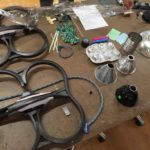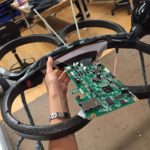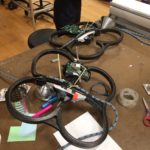After this class’ discussion and exercise, and reading Chris Crawford’s definition and Bret Victor’s rant, how would you define physical interaction?
After reading the authors’ thoughts, I developed a greater appreciation for the nuances involved in designing interactivity. I agree it’s a buzzword that is overused. I also agree that there is a spectrum of interactivity and it is important to have meaningful communication with all ‘actors’ involved.
I feel Crawford’s definition of interaction was mostly accurate. Can you call a rug with a map on it interactive when a plain color rug is not. I can see why it’s easy to mislead people when the term is so loosely used. A guitar tuner is responsive while an automated guitar peg tuner is interactive. But is the peg tuner really interactive? Are you playing with the expectation of being corrected throughout the show? Does this function affect your playing and vice-versa? Is a 3D movie more interactive than a 2D one if at all?
The other side of the coin is that is do we want interaction everywhere? Does everyone need to have a romantic relationship with their toilet. Who wants to hear a greeting when you poop. Do I want the LEDs in the toilet bowl to change when it’s reading my dehydration level? I think as an artist or engineer this should always be in the back of their minds.
I enjoyed reading the rant even though it was a bit exhaustive. The cliche Minority Report navigation system, or Star Trek consoles are really not the future of UI. People are too lazy to raise their hands above their heads let a lone stand up while reading emails. Flat surfaces are unnatural and don’t really exist in nature. I hate when I was forced into ditching my sliding keyboard on my phone for a on-screen version. The technology has improved by leaps and bonds since then, but I still know a flat surface is horrible for typing on. Also, consider how those who have accessibility issues are being further pushed to the sidelines.
How is something flat designed for humans to use? Victor was justified in his frustration and lack of ingenuity in future of interactivity visualizations. We should not try to unify everything into a flat screen like device. Traditional artists use pens, brushes so a successful UI for them comprises of a tactile digital version of a pen/brush. I feel this idea is very important to keep in mind as one designs products for interaction.
What makes for good physical interaction?
A good physical interaction should be forgettable, mundane and a derivative of your everyday life. If you asked me what was the process of entering a subway in Japan. I would remember being outside and then being inside. I don’t want to have thoughts about the work done in the middle of it.
Are there works from others that you would say are good examples of digital technology that are not interactive?
I would say e-books and other e-publications tend to fall on the non-interactive side. Specifically novels tend to be very straightforward as opposed to magazine publications who are more engaging with web links and embedded video etc.





























